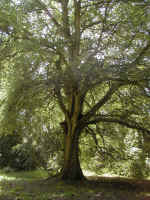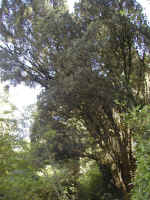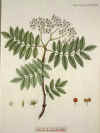|
|

|

|
Ogham
The Ogham Tree Alphabet
Below is a list of the
trees which make up the Ogham Alphabet (BethLuisnion)
|

|
|
|
Beth (BEH), Birch
- The silver birch (Betula pendula Roth) is the most common tree birch in
much of Europe. It is one of the first trees to colonize an area after a
mature forest is cut; this is probably a large part of its symbolic
connection with new beginnings. It grows up to 100 feet high, but is more
often found in spreading clumps on sandy soils. The common birch (B.
pubescens Ehrh.) is almost as widespread as the silver birch, but grows
primarily on acid or peaty soils.--it can reach 65 feet in height. |
 |
|

|
Luis (LWEESH), Rowan
- The rowan, or mountain ash (Sorbus aucuparia L.) is related to
serviceberries. The red berries were historically used to lure birds into
traps, and the specific epithet 'aucupari'a comes from words meaning
"to catch a bird". Rowans thrive in poor soils and colonize
disturbed areas. In some parts of Europe they are most common around
ancient settlements, either because of their weedy nature or because they
were planted. Rowans flower in May. They grow to 50 feet and are members
of the Rose family (Rosaceae). They are cultivated in North America,
especially in the northeast. |

|
|
|
Nion (NEE-uhn), Ash
- the common ash (Fraxinus excelsior L.) is a major tree of lowland
forests in much of Europe, along with oaks and beeches. It grows to 130
feet in open sites, with a broad crown reminiscent of American elm trees.
Ash was and still is an important timber tree, and is a traditional
material for the handle of a besom; it is also a popular wood for wands.
The common ash is occasionally cultivated in NorthAmerica, and similar
native ash species are widely grown as street trees. Ashes are members of
the Olive family (Oleaceae). |
 |
|
|
Fearn (FAIR-n),
Alder - The common alder (Alnus glutinosa (L.) Gaertner)
is common along lowland rivers, where it grows with aspens and willows.
Like willows, alders sprout from stumps--this allows them to regenerate
after heavy flooding. In protected sites they may grow to 65 feet tall.
Their leaves are more blunt-tipped than most North American alders, which
look more like the grey alder (A. incana (L.) Moench). Like ashes,
European alders are not widely cultivated in North American (they are
often sold as black alders), but several native species are. Alders are
members of the Birch family (Betulaceae).
|
 |
|
|
Saille (SAHL-yuh),
Willow - Like North America, Europe is home to a large
number of willow species Two common tree willows are the white willow
(Salix alba L.) named for the whitish undersides of its leaves, and the
crack willow (Salix fragilis L.) for the propensity of its branches to
"crack" off (probably another adaptation to flooding). Both
species grow along with poplars and alders along lowland rivers. They can
reach 80 feet in height, and they both vigorously sprout from stumps. The
white willow is sometimes grown in cultivation in North America. Willows
are members of the Willow family (Salicaceae). |
 |
|
|
Huath (HOO-ah),
Hawthorn - Like willows, hawthorns have many species in
Europe, and they are not always easy to tell apart. All are thorny shrubs
in the Rose family (Rosaceae), and most have whitish or pinkish flowers.
The common hawthorn (Crataegus monogyna Jacq.) and midland hawthorn
(Crataegus laevigata (Poiret) DC.) are both widespread. They are common in
abandoned fields and along the edges of forests. Both are cultivated in
North America, as are several native and Asiatic hawthorns. |
|
|
|
Duir (DOO-r), Oak
- The oak of myth and legend is the common oak (Quercus robur L.). It is
sometimes called the great oak, which is a translation of its Latin name
('robur' is the root of the English word "robust"). It grows in
the lowland forests, and can reach a height of 150 feet and age of 800
years. Common oaks are deciduous, losing their leaves before Samhain and
growing new leaves in the spring so that the trees are fully clothed by
Beltane. Common oaks are occasionally cultivated in North America. Oaks
are members of the Beech family (Fagaceae).
|
|
|
|
Tinne (CHIN-yuh),
Holly - The holly (Ilex aquifolium L.) is a shrub growing
to 35 feet in open woodlands and along clearings in forests. Hollies are
evergreen, and stand out in winter among the bare branches of the
deciduous forest trees that surround them. Hollies form red berries before
Samhain which last until the birds finish eating them, often after Imbolc.
Hollies are members of the Holly family (Aquifoliaceae). The common holly
is often cultivated in North America, as are hybrids between it and
Asiatic holly species |
 |
|
|
Coll (CULL), Hazel
- The hazel (Corylus avellana L) is the source of hazelnuts. The wood of
the hazel shrub has been used for centuries in the makeing of wands. It
forms a shrub up to 20 feet tall, inhabiting open woodlands and scrubs,
hedgerows, and the edges of forests. The filbert nut in North American
groceries is Corylus maxima, a related species. The European hazelnut is
cultivated in North America, primarily as an ornamental. Hazelnuts are in
the Birch family (Betulaceae). |

|
|
|
Quert (KWAIRT),
Apple - When most of us think of apples, we think of the
domestic apple, but the ogham tree was most likely the European crabapple
(Malus sylvestris Miller). This tree grows to 30 feet in moist fertile
soils in oak woodlands, and has been extensively cultivated. The fruits
are small versions of the domestic apple, and also show the pentacle when
cut across. Cultivated crabapples in North America are usually Asian
species, but this species is a common rootstock for apple trees. Apples
are in the Rose family (Rosaceae). |

|
|
|
Muin (MUHN, like
"foot"), Blackberr* In Ireland Muin refers to the
Bramble or Blackberry
shrub (Rubus fruticosa) which grows wild along every hedgerow in Ireland it
has a prickly spreading vine system and fruits in September a rich fruity wine
can be made from the fruits.
|

|
|
|
Gort (GORT), Ivy
- Ivy (Hedera helix L.) is also a vine, growing to 100 feet long in beech
woods and around human habitations, where it is widely planted as a ground
cover. Ivy produces greenish flowers before Samhain on short, vertical
shrubby branches. The leaves of these flowering branches lack the
characteristic lobes of the leaves of the rest of the plant. Like holly,
ivy is evergreen, its dark green leaves striking in the bare forests of
midwinter. Ivy is widely cultivated in North America. It is a member of
the Ginseng family (Araliaceae). |
 |
|
|
Ngetal
(NYEH-tl), Reed - The term "reed" is used with great
imprecision in North America, but it is clear that the reed of the Ogham is the
common reed (Phragmites australis (Cav.) Trin. ex Steudel). This is a giant
grass, with stems as high as 12 feet. It grows in marshy areas, where it often
forms dense stands. The vertical stems live only a single year, dying in the
autumn and being replaced with new green shoots in the spring. The dead stems
rattle and whisper in lateautumn winds. In North America it is widespread in
cooler climates. Common reed is in the Grass family (Poaceae, or Gramineae).
Bridget's triskeles and corn dolly's are made from
these reeds in Ireland they are cut while they are still green and fashioned
into fertility icons.
|

|
|
|
Straif
(STRAHF), Blackthorn - The blackthorn (Prunus spinosa L.) is a
relative of cherries and plums, and is the source of the sloe fruit. The fruit
has been used for centuries to make a potent alcohol, that was drunk during
Pagan rituals in Eastern Europe, and in British Isles. It is a thorny shrub
growing to 12 feet, often forming thickets on south-facing slopes. The
blue-black fruits are edible, but bitter until after the first frost.
Blackthorns are seldom cultivated in North America. They are members of the Rose
family (Rosaceae).
|

|
|
|
Ruis
(RWEESH), Elder - The common elder (Sambucus nigra L.) is a
shrub growing to 30 feet in damp clearings, along the edge of woods, and
especially near habitations. Elders are grown for their blackish berries, which
are used for preserves and wine. The leaf scars have the shape of a crescent
moon. Elder branches have a broad spongy pith in their centers, much like the
marrow of long bones, and an elder branch stripped of its bark is very
bone-like. Common elders are seldom seen in cultivation. Elders are in the
Honeysuckle family (Caprifoliaceae).
|

|
|

|
Ailm (AHL-m) elm* In Ireland Ailm refers to the elm (Ulmus procera) which
grows all over Ireland. |

|
|
|
Onn
(UHN), furze - Furze, or gorse (Ulex europaeus L.), is a thorny
shrub growing to six feet tall. It grows in heaths, moors, pastures, and open
woodlands. It produces bright yellow flowers around the time of the spring
equinox, which were very popular in pagan fertility rituals throughout Europe
and the British Isles for many centuries. It is not often cultivated in North
America, but is a serious weed in central California and some other areas. Furze
is a member of the Pea family (Fabaceae, or Leguminosae).
|

|
|
|
Ura
(OO-rah), heather - Heather (Calluna vulgaris (L.) Hull) is a
shrub growing to six feet. It is a major component of the vegetation type called
"heath", the source of the term "heathen". It is evergreen,
and produces bell-shaped pinkish flowers in the late summer. There are a number
of other plants called "heath" or "heather" in the genera
Erica, Phyllodoce, and Cassiope, relatives of Calluna, and are similar in
appearance. Calluna is cultivated in North America with several Erica species
from other parts of the world. Heather is a member of the Heath family
(Ericaceae).
|

|
|

|
Eadha
(EH-yuh), poplar - The aspen (Populus tremula L.) grows to 65
feet along rivers. It sprouts from the base and may form clumps or thickets. The
black poplar (Populus nigra L.) reaches 100 feet in sandy and gravely soil along
rivers. The white poplar (Populus alba L.) is of similar size and habitat, but
is more common in southern Europe. Both species are cultivated in North America
(the "Lombardy poplar" is a form of black poplar). The North American
aspen (P. tremuloides) is very similar to the European aspen. Poplars are
members of the Willow family (Salicaceae).
|

|
|

|
Idho
(EE-yoh), iodho (EE-woh), yew - The yew (Taxus baccata L.) is a
slow-growing conifer, living as long as 1000 years and reaching 65 feet, they
are known for their strength and resistance to the cold. It is much less common
in recent times because of overharvesting (its hard, springy wood was the source
of English longbows). The evergreen needles are very broad, and the seeds are
produced in red, berry-like cones. Yews are toxic; one of the toxic compounds,
taxol,
might be an effective treatment for some cancers. Yew is in the Yew
family(Taxaceae).
|

|
*all
photographs ©Shee-Eire
top

|